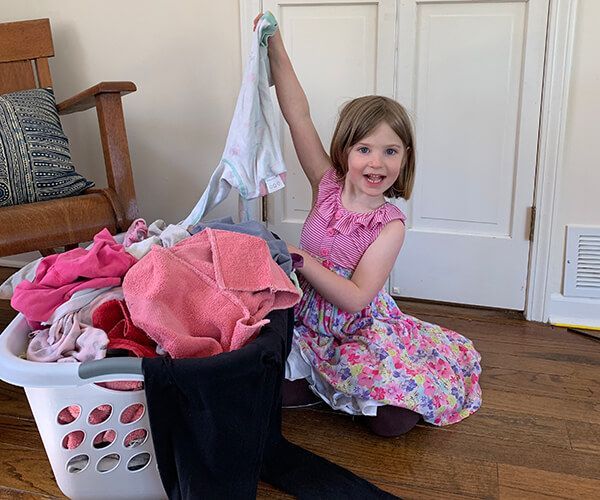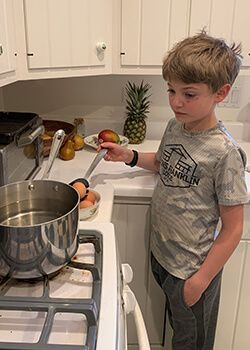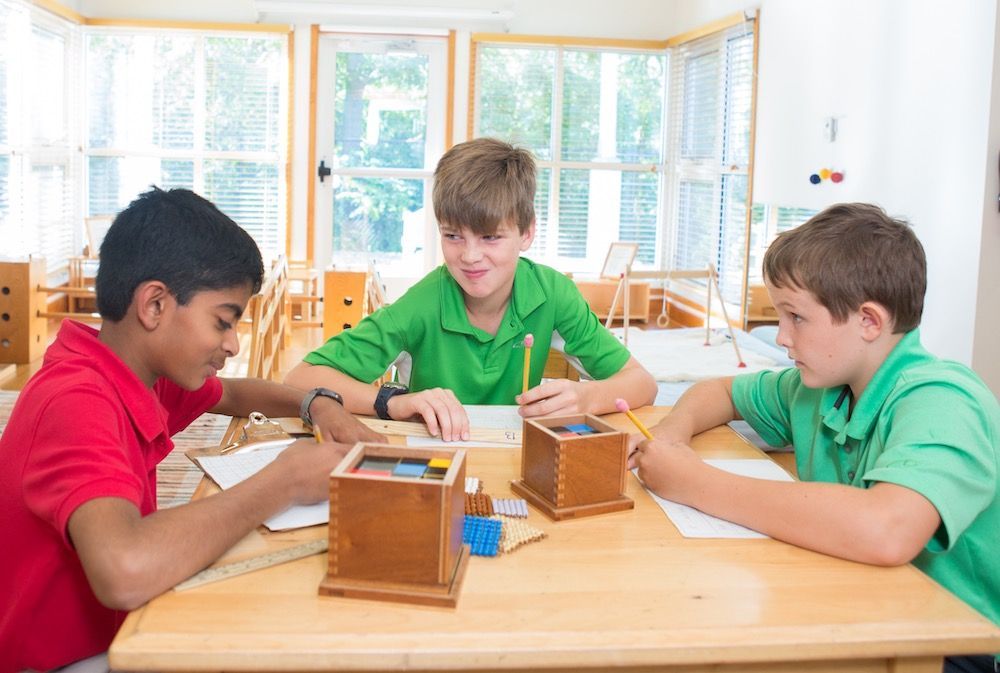
I know that chores are an important part of my children’s development. Chores are good for their sense of responsibility and community and good for their self-confidence and self-esteem. Chores make them better friends, students, and citizens. Chores teach them how to serve. I know all of this. And yet, the chore system in our home hasn’t been impressive. Our children have made their own lunches for school, for the most part. They clean their rooms every week, for the most part. They clean up after themselves, for the most part. They help with dishes and tidying, for the most part. I regularly let die and then resurrect a rotating chore chart, which mostly just causes them to complain about whose turn it is to wash dishes. Until now, I would describe the chore expectations in our house as “maybe good enough.”
Why don’t we have a better chore system in our house? Why doesn’t it feel more sustainable whenever we try a new system? As best I can tell, there are two reasons for this. The first, and probably the most relevant, is that so far we have not had a true “need” for our children to consistently contribute to our home care. And secondly, I keep trying out systems that work for other people, without considering how it matches our family’s particular personality and discipline.
Children as Contributors
Our family has lived in inarguable comfort since its inception. While parenting can be challenging, survival has never been a question, nor have we dealt with true hardship. We’ve never worried about running out of food, we’ve always been able to get medical attention when we need it, our house is cool in the summer and warm in the winter, and we have toys and books to play with. Additionally, my husband and I have been able to take breaks as parents through babysitters and friends, and, of course, when our children are at school.

All of this means that our children’s efforts in caring for the home have been somewhat contrived. I ask them to wash their dishes before we go to school, but if we are in a hurry and it doesn’t get done, it doesn’t take much time or effort for me to do it myself when I get back from the school drop-off. In fact, this happens too often without me even realizing it. Similarly, I ask for their help with the laundry, but since they are at school all day, it is likely that I will end up folding the clothes myself when I have some downtime. And again, this is often an unconscious action! I have to be fully aware and disciplined about saving chores for my children and then following through with asking them to do them. Often this takes more energy than doing it myself, especially if they are reluctant to do it.
All of this has changed since Illinois’ governor issued a stay-at-home directive in the middle of March. While we still have a great deal of comfort, we have new challenges and a taste of hardship. Now, my husband and I no longer have breaks when our children are not underfoot, and our children are home to make more messes and go through more dishes! This is added to the stress of what’s going on in the world right now and the challenges of easily obtaining groceries and medical care. Life feels overwhelming too much of the time.
So what does this have to do with our children and their chores? It means that we truly need their help in our home. Right now, I can be sure every day that my children are not too tired from school, extracurricular activities, or playing with friends to help out. They are essential members of this household, and we need their hands, energy, and time to maintain our home and emotional health. I might be able to tackle all the housework on my own for a while, but eventually it will become unsustainable physically and emotionally. And why would I? I already know that contributing to housework is good for children in a hundred different ways. Now is my chance to instate a chore system in our house that benefits them as well as me.
Finding a Chore System
I’ve tried a lot of chore systems over the years--a lot that didn’t end up working for us. I tried a rotating job chart where I divided household tasks into three parts for our three children, and we changed every month. This was hard for us because I never could establish the right balance of meeting our children’s capabilities (ages 5, 7, and 9) with being somewhat fair in terms of time and energy. Mostly no one wanted to be stuck on dishes so I had to remember to create a new list every month, and restructure the lists each time. If I missed the list by a week or two, then we were already halfway into the next month, and I had to decide how to handle the uneven time frame.
After this, I decided that we should just trade day by day. The older two would alternate being my helper inside the kitchen or being my helper outside of the kitchen on odd and even days, and the youngest would always be in charge of tidying bathrooms and the mudroom. This worked for a while, and was nice because I didn’t need to keep creating a job chart. But then our youngest started asking why she didn’t get a chance to help in the kitchen, and the job load could end up being quite unbalanced based on laundry and menu, so I decided to scrap this job system, too!

Part of the issue is that there is not a one-size-fits-all system. Every family has different challenges and strengths. Parents who are very organized and good at getting to tasks probably would be suited for the job chart approach. Parents with an even number of children may be able to work with the odd-day even-day approach. The trouble is that our family has neither of those things!
In desperation, around week three of quarantine, I asked my husband what he recommended. I was still doing too many of the household tasks, and I needed a better system for structuring chores. Luckily, he has one of the most organized minds I know, and he had an idea immediately. First, he observed that there were three main areas of work in the house: Laundry, food preparation, and kitchen clean-up. Then, he suggested that I give each child one of these jobs every week. We would rotate every Sunday. As for the jobs like straightening up the mudroom, tidying the floors, and putting away toys, we would all chip in.
It seemed too simple to work, but that, I suspected, was the genius of it.
Getting Started
We started this endeavor as we start all our family endeavors: With a family meeting. Family meetings are a new concept to me, but I’ve found that if we serve popcorn, keep it short, and make sure everyone has a chance to share, they are a great way of cultivating camaraderie and enthusiasm. They also help our children feel invested in whatever is coming next.
We explained the state we were in: There is a lot to do in our home, and we all need to chip in to make it work. We observed that what we had been doing wasn’t working. And we pointed out that if Mom and Dad were tired from doing too much housework, we didn’t have time or energy to enjoy activities as a family, like baking, cooking delicious meals, exploring the ravine, playing outside, throwing the baseball, and so on. This provided the natural motivation for them to help.
Then we proposed the chore solution. Our children immediately grasped the simplicity of it, and appreciated the fairness of this new system. We made it clear that with their help, our home would be cleaner and easier to live in, and that we would have more time to enjoy the positive aspects of quarantine (and life!) together. We let them ask questions, and mostly they wanted to know whether they got to pick the lunch menu when they were on food preparation. My answer was, “Yes, for the most part.” (With a little guidance, so as to avoid Mac and Cheese every single day.)
I wrote the jobs on a piece of paper on the refrigerator to help us all have respect for the system, and added “Floors, mudroom, bathroom, and toy clean-up: Everyone” just to make sure they understand it is also a task that needs to get done. This way, everyone continually sees that this is now an important part of our home and that the jobs will be rotated fairly.
Laundry, Food Preparation, and Dishes
For laundry, our nine-year-old can get clothes out of the dryer, fold them, divide them into stacks, and distribute them to the individual bedrooms, where each person puts their own away. I’m sure he could run the washer and the transfer to the dryer, but I remember too vividly shrinking some of my mom’s sweaters in the dryer when I was a child, and I’ve been reluctant to leave this possibility in his hands! Our seven-year-old is fully capable of the same, but the clothes aren’t as nicely folded. Our five-year-old gets overwhelmed quickly by a big pile of laundry, and tends to need me to sit with her while she folds, helping her fold larger clothes. I also help her carry the large laundry basket upstairs and manage the bigger piles of clothes as they go to everyone’s room. If I had a younger child, they would be my “assistant” in this category—helping me fold, making a stack of rags, sorting out the clothes into piles, and carrying individual items to bedrooms. Even a two-year-old can participate!

For food preparation, I’ve been interested to observe that our seven-year-old accomplishes more than our nine-year-old. This seems to have less to do with age and more to do with a willingness to make mistakes. Our seven-year-old will happily make quesadillas in the toaster and shrug if they burn or bake cookies and forget the eggs. This has been a very important insight! And one I would not have been able to make without this simple framework for our chores. With this knowledge, our seven-year-old is a handy sous chef, and she is also independent in the kitchen to prepare meals. I make sure she checks in with me for all stove and oven related activities, knowing she tends to pay less attention to detail! For our nine-year-old, I continue to prompt him to think for himself, to interpret recipes on his own, and emphasize a friendliness to error (“Looks like cookies baked with twice as much butter still taste pretty good!”). Our five-year-old tends to be more of a “sous chef” in the kitchen as I prepare the meals. And this would work for younger children and toddlers, too, who are extremely capable of many activities in the kitchen, including setting the table, chopping and peeling fruits and vegetables, and mixing ingredients.
The dishes are straightforward, although, again, I have been interested to see how individual personalities reveal themselves! Our nine-year-old is very independent with dishes, and I am impressed at how he will persevere with very dirty pots (eggs in a cast iron skillet defeat even me!). Our seven-year-old is very competent practically speaking, but needs help understanding standards—what a clean pot actually looks like—and I frequently need to remind her not to empty a dirty dishwasher! Our five-year-old is independent with this, also, but needs help with the dirtiest pots and putting dishes in the dishwasher efficiently. She also tends to become overwhelmed by a full sink. For children younger than this, I would assign table-clearing tasks (one dish at a time!), and put them at the sink with a safe stool. If the sink is filled with a little water and dish soap, they can scrub the dirtier dishes, which may need another scrub from a parent when they are done! All ages are capable of emptying the dishwasher, although the littlest ones may only put away the child-size dishes in the low cabinets.
How We've Been Doing
My suspicion was correct. The genius of this plan is in its simplicity. Our children respect the fairness of the division of labor. In fact, they still can’t decide which is the best and which is the worst of the jobs. It rotates often enough but not too often. And it gives me someone to rely on for almost every task I have to do regularly in our home. There is a lot that I can fully turn over to them with various degrees of expectations and difficulty based on their age and skill level.
When these daily jobs are met with resistance, I remind them that we need their help, and that their contribution matters for our family. I also employ phrases like “teamwork makes the dreamwork” and “there is no I in team” which makes our older two giggle, and invites lengthy explanations of what exactly that means with our youngest. When there is a great deal of reluctance, we talk about the fun things we’d like to do next, but can’t get to until the work in the home is finished—crafts, visiting a forest preserve, watching a new documentary series about wildlife, playing games by the fire, having a FaceTime chat with friends or family, and so on. Then we make sure we are disciplined about enforcing this rhythm to life—work first, play later.
Finally, and perhaps most importantly, we thank everyone for their work and celebrate everyone’s contributions, children and adults alike. This is the most genuine way of building our children’s self-esteem and confidence, as they see that the work they do matters, both in the practical maintenance of their home, and also their emotional relationships with the people around them.
Final Thoughts
This newfound emphasis on chores in our home is good for all of us. It relieves some of the pressure for my husband and me, and it is one of the most valuable contributions to our children’s development we can make in our own home. This emphasis feeds our children’s bodies and it also feeds their minds and hearts. Maria Montessori recognized this phenomenon in children, over a hundred years ago, when she observed, “Joy, feeling one's own value, being appreciated and loved by others, feeling useful and capable of production are all factors of enormous value for the human soul.” What better way to do this in our homes than to allow them to contribute and be appreciated for it? Our chore system is working for now, and I am grateful for this opportunity to have established something that can be a part of our household for years to come.


